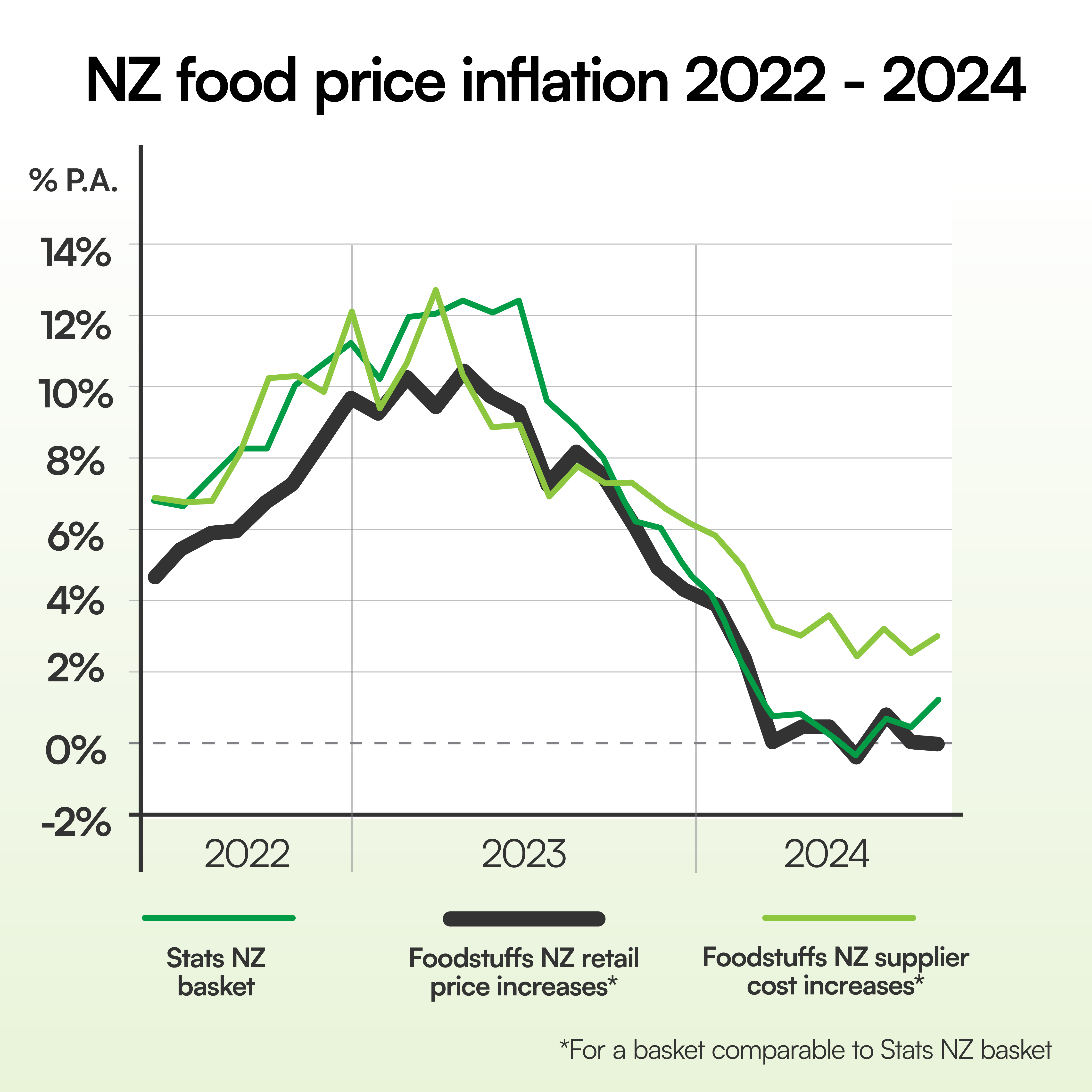Foodstuffs co-ops highlight GST difference with overseas markets after recording another month of zero food price inflation

• Stats NZ records 1.2% p.a. food price inflation in year to September 2024
• Foodstuffs co-ops record 0.0% p.a. average retail price increases in comparable basket
• NZ continues to benefit from one of the lowest rates of food price inflation in the OECD
• Co-ops say comparing NZ prices with offshore markets often ignores differences in GST
The Foodstuffs grocery co-ops are pushing back on claims NZ food prices are higher than overseas, as the country again records one of the OECD’s lowest rates of food price inflation.
The co-ops, whose member families individually own and operate the country’s New World, PAK’nSAVE and Four Square stores, have recorded another month of food price inflation (FPI) below the national average. While Stats NZ’s FPI for September 2024 increased 1.2% p.a., the co-ops recorded no increase or 0.0% p.a., on average, for their comparable basket of goods.
It’s the third time since March that the Foodstuffs FPI rate has been zero or lower, and the seventh consecutive month both rates have been less than 1.5% p.a., meaning New Zealand continues to have one of the lowest FPI rates in the OECD. By comparison, Australia recorded 3.4% p.a. in the year to August, the Eurozone 2.3% p.a., the USA 2.1% p.a. and the UK 1.3% p.a.
Foodstuffs NZ Managing Director Chris Quin says the co-ops are acutely aware that affordable food is a pressing issue for New Zealanders, so have worked hard to tame food price inflation over the past two years despite significant severe weather events and international pressures.
“As two external reports highlighted recently, global factors play a big role in New Zealand food prices,” says Quin. “Last month, the Commerce Commission’s Annual Grocery Report noted the supply chain disruptions caused by Covid and the Ukraine conflict.[1] This month, an Australian academic cited our heavy reliance on imports and exclusion from global supply chain corridors.[2]
“What both didn’t mention, and what others who compare prices here with those overseas tend to overlook, is most OECD countries have lower or no GST on some or all grocery foods.“For example, Australia doesn’t charge GST on meat, fish, produce, cheese and eggs, plain milk and cream, bread and spreads, bottled water, tea and coffee, cooking ingredients and oils, or infant formula.[3]
Likewise, in the UK and Ireland they don’t have GST on most grocery foods.
“Had the GST exemptions in those three countries been applied to New Zealand in a recent study by Australian researchers, who compared a basket of over 40 products at each country’s two main supermarket brands, the total price of the PAK’nSAVE basket would have been lower than Australia’s and lower than Ireland’s, and less than 10% more than the UK’s.
“To be clear, this is not a call to remove GST from food in New Zealand, as we think our simple low-cost tax system makes sense. But it is important to be conscious of all factors at play when comparing prices here to overseas.
“Our co-ops have been transparent about the average breakdown of the retail price on shelf, with 13 cents per dollar being GST and less than four cents per dollar our net profit after tax, while around two-thirds is the cost of buying the product from suppliers – which rose 3.0% p.a. on average in September in our comparable basket of goods.

“Foodstuffs’ experts will be taking a close look at prices in comparable markets overseas over the coming months because any valid comparison needs a robust methodology that carefully considers the basket of goods included, their weights and unit measures, different sales taxes and fluctuating exchange rates, and should be conducted over an extended period.
“At the same time, our co-ops will continue to challenge ourselves to do what we can as two regional New Zealand businesses to find greater efficiencies, which was the major driver behind our proposed merger, and one of the best things we can do to provide our customers with savings at the checkout,” Quin says.
[1] Commerce Commission Annual Grocery Report [comcom.govt.nz], p.62
[2] RNZ.co.nz New Zealand groceries more expensive than Australia, UK and Ireland – research [rnz.co.nz]
Notes for reporters/editors
Methodology
Stats NZ measures food price inflation by tracking the prices of individual items that make up a representative ‘basket’. Foodstuffs NZ measures the prices of a basket of products in the same categories Stats NZ monitors, applying the same weighting and methodology to calculate a year-on-year rate, comparing the latest month with the same month one year earlier.
Headline stats for latest month (all figures year-on-year)
• Stats NZ’s food price index was up 1.2% in the year to September 2024
• Foodstuffs NZ data for a basket of products in the same categories Stats NZ monitors:
o retail prices across all stores were the same (0.0% change, on average) as in September 2023
o the average cost of supplied goods was 3.0% higher, on average, than September 2023
• Latest Infometrics-Foodstuffs NZ Grocery Supplier Cost Index (GSCI) shows the ‘list price’ suppliers charged the co-ops across 60,000 goods rose 2.3% p.a. in the year to September.
References: overseas sales tax exemptions on food
• Australian Tax Office, ‘GST-free food’ [ato.gov.au]
• Ireland Revenue, ‘VAT treatment of food and drink supplied by wholesalers and retailers’ [revenue.ie]
• UK Government, ‘Guidance: Food products (VAT Notice 701/14)’ [gov.uk]
Graph – available for download here: https://we.tl/t-pe2YEqxoyJ
